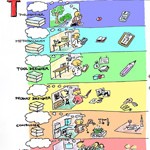Doing design as a part of doing Research
New: with Elisa Giaccardi, I authored an invited chapter on Research through Design for the Encyclopedia of Human-Computer Interaction of the Interaction Design Foundation.
Stappers, P. & Giaccardi, E. (2017) Research through Design. In Soegaard, M. & Friis-Dam, R. (eds.), The Encyclopedia of Human-Computer Interaction, 2nd edition. Retrieved from http://www.interaction-design.org/literature/book/the-encyclopedia-of-human-computer-interaction-2nd-ed/research-through-design
Research and Design have had interesting relations over the last decades. On the one hand designing (e.g., design processes, activities, methods, techniques, tools) and design (results, products) have become object sof scientific study. On the other hand, there has been a surge in research methods which incorporate design elements (such as visions, making stories about futures, constructing prototypes for not-yet-existing situations).
In education, we see that research is explicitly taught as a part of design training (one of the many examples are the courses Context & Conceptualization and DfI research methodology in the Design for Interaction MSc program Design for Interaction that I have been involved in). Doing research as part of designing has become widely accepted. But the reverse is yet to be widely recognized (see below).
research versus design?
But still, many are uneasy about the relation of research and design. Traditionally, the two have been viewed as opposing: the former focusing on proven knowledge about the present and past, the latter about speculative action in the future.
In my view, the two can have much in common, where both strive for evolving a better understanding of part of the human condition, preferably with positive consequences for that condition.
Research through design
Over the past decade, I have been involved in research, where designing was used as the way to produce new knowledge. Especially prototypes (of visionary design tools or techniques) have played a central role in this, and researchers who started their PhD research with a MSc in design, such as Ianus Keller, Froukje Sleeswijk Visser, and Daniel Saakes.But also these (and many others) who conducted research-through-design projects as part of their MSc projects. Such projects have both research and design outcomes: new knowledge (which should be shared through publication) and products (which can be ‘real-world manufactured goods’, or more often methods and techniques that can -and are- used in design practice).
Where I differ from some others is in that I believe that the act of designing itself is a place where knowledge is generated. It is more than giving a theory-derived hypothesis a physical manifestation so that it can be tested in an experiment. Whereas the latter is obviously acceptable science, it gives a very limited role to the step of designing (which may well be, and often is, outsourced); the act of designing becomes a generative research action only if the designing itself is used (probably by reflection, as Schön frames it) to bring about new insights.
The great challenge, I think, is not to let the new insights dissipate, but actually get it known to the right audiences (who may not yet be receptive for knowledge that is generated by unorthodox ways, or ready to recognize that as ‘science’; but that is a larger part of the historic struggle for recognition of the knowledge value of engineering).
Meta-levels of design and research
More in detail
I published a few papers on these topics.
Research through design
Stappers, PJ, & Giaccardi, E (2017) Research through Design. Chapter in: the Encyclopedia of Human-Computer Interaction, 2nd edition. URL: https://www.interaction-design.org/literature/book/the-encyclopedia-of-human-computer-interaction-2nd-ed/research-through-design
Stappers, PJ, Sleeswijk Visser, F, & Keller, AI (2014) The role of prototypes and frameworks for structuring explorations by research through design. In: Rodgers, P & Yee, J. (Eds) The Routledge Companion to Design Research. Taylor & Francis. ISBN 978-0415706070, 163-174. Download draft
Stappers, PJ (2007). Doing design as a part of doing research. In R Michel (Ed.), Design research now: essays and selected projects (pp. 81-91). Basel: Birkhauser. Download draft | source
Stappers, PJ (2006). Designing as a part of research. In R vd Lugt & PJ Stappers (Eds.), Design and the growth of knowledge: Best practices and ingredients for succesful design research (pp. 12-17). Delft: ID Studiolab Press. Download source
Meta-levels of design research
Stappers, PJ & Sleeswijk Visser, F (2014) Meta-levels in design research: Resolving some confusions. In: YK Lim, K Niedderer, J Redstrom, E Stolterman, A Valtonen (eds.), Proceedings of DRS 2014: Design’s big debates. DRS 2014: Design’s big debates, Umea, Sweden, June 16 – 19. Download draft
Stappers, P.J., & Hoffman, R.R. (2009) Once more, into the soup. IEEE Intelligent Systems, 24 (5), 9-13. Download draft | IEEE source | poster
Stappers, P.J. (2009) Meta-levels in Design Research: Clarifying the Roles we play in Design, Research, and Elsewhere. In: Lee, K., Kim, J., & Chen, L. International Association of Societies of Design Research (iasdr): Rigor and Relevance in Design, 18-22 October, Seoul, South Korea. Download draft | source | poster


